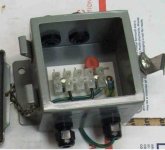RIO and DH+ are (were) one and the same, sharing the same hardware in terms of cable, connection plugs, transceivers, and terminating resistors, but the communications protocols were different. The only way to tell them apart was the colour coding of the cores on the blue cable.
I can't remember now but one of them went Blue-Shield-Clear, and the other went Clear-Shield-Blue. And if everyone stuck to that, all was well. But commissioning Joe knew that if a RIO or DH+ station wasn't communicating, you just swapped over the Blue and Clear insulated cores, the trick was to do that at the right end of the cable !! All of a sudden a DH+ network looks like RIO, and vice versa ! Of course, you have to remember that neither DH+ nor RIO could detect the colour of the cable insulation !!
Anyway, that's a digression from the thread. I just want to say that most people "daisy-chained" their RIO networks at the 3-pin plugs, putting both cables into the plug. Ever so slightly fugly IMHO.
A "decent" RIO (or DH+) installation would have used "Station Connectors", which is a fancy name for a metal box with some connector blocks in. These allowed you to attach a single "drop-line" to your panel, much like the Controlnet "bus" system. Station Connectors could be used on RIO or DH+ interchangeably.
Most times the terminating resistor would be installed at the last station connector on the "bus", which although not technically correct, (because the T.R. was not at the end of the cable run to the device), was largely acceptable for the incredibly robust DH+/RIO technology !
It could be that the OP's RIO network used station connectors, and that removal of the cable would be a much easier job, rather than leaving it for a later project.
Having said that, it shouldn't be a hard job to trace the cable back and disconnect it at the previous "tap" onto the network, whether that was done by daisy-chaining, or by using Station Connectors. You just have to find out which panel (or Station Connector) the cable comes from, and disconnect accordingly, remembering to re-install the terminating resistor at the "end-of-line". Perhaps plan to do that on this project, and have no risk of someone just chopping the cable to remove the defunct panel ....
I once worked in a brewery that began to get RIO issues on on system, which came and went at seemingly regular times of the day, and they could not track down the cause. It turned out, and it was discovered during a site survey by RA, that a redundant panel in a remote location, had a "drop-line" going into it, which had been disconnected from the ASB, coiled up, and left in the bottom of the panel. The panel had been gutted, all the control gear, panel switches, HMI etc. had been removed. That process area was "washed-down" twice a day with high-pressure lances, leaving a nice puddle of water in the redundant panel, which the bare ends of the RIO cable enjoyed a twice-daily swim ....






